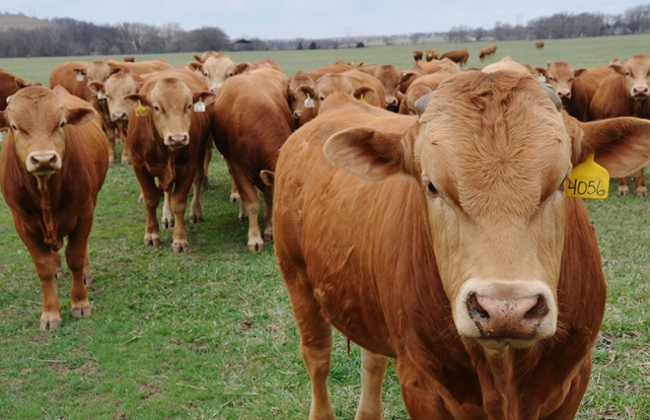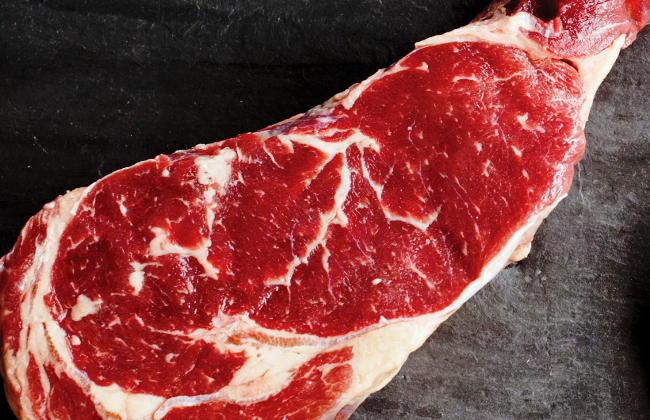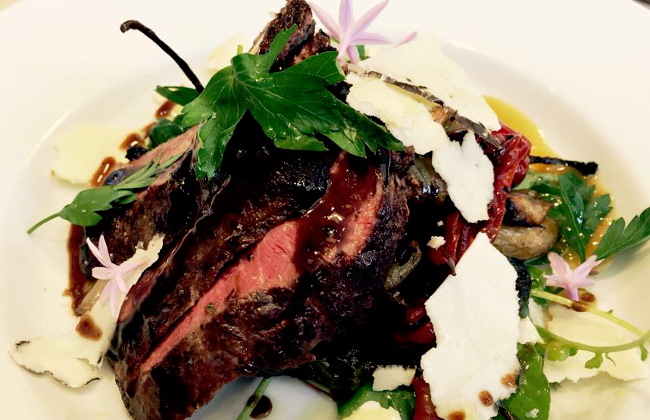Japanese Beef in American Pastures
Japanese beef has long been heralded for the most prestigious and delicious cuts of beef in the world. Until a few years ago, the cost of authentic Kobe, Matsuzaka, Omi, and Akaushi beef was so prohibitive, and the restrictions on trade were so stringent, few Americans have ever tasted anything except “Kobe-style” beef – a quality product but still a runner-up to the unique flavor and texture of the Japanese herds. But thanks to one pioneer and 11 head of cattle, the chance to experience the exquisiteness of Japanese beef, without breaking international law or allocating a week’s salary to a single steak, has arrived. This is a unique story starts 2,500 years ago, before dynasties, shoguns, or emperors ever ruled the majestic mountains and fertile valleys of Japan.

A herd of American Akaushi Wagyu in South Texas. The name “Japanese Red” is reflective of the rich caramel and amber color of their coats.
Historians record domesticated cattle, pigs and chickens being introduced to Japan from the Asian continent between the years 500BC and 300AD. For more than 2,000 years cattle were raised for labor, not for meat and milk. Buddhist leaders prohibited the consumption of flesh – especially from four legged animals – and horses were solely reserved for military ventures. Cattle were the “workhorses” of mining, forestry, transportation, and rice farming. The discriminatory practices of selection for able-bodied cattle resulted in unique native working breeds.
During the Meiji Restoration of 1867, Japanese imperial leadership lifted the national ban on meat consumption. As a new market emerged, the decision was made to transform the native breeds to meet market demands. British Shorthorn and Devon breeds were imported and introduced to the native herds. By 1910 breed crossing ceased, and in 1919 the Japanese government introduced registration and selection of the “improved Japanese cattle”. The core breeds derived from interbreeding became collectively known as “Wagyu”. Pronounced Wag-You, Wagyu is the direct translation of its two grammatical parts, “wa” and “gyu” meaning Japanese and cattle, respectively. In 1944 the Japanese government rationalized the registration process and formally recognized three Wagyu breeds – the Akaushi (Japanese Red), the Kryoshi (Japanese Black), and the Japanese Polled. The Japanese Shorthorn was not officially recognized until 1957.
In Japan, the Akaushi is the only breed of free-grazing cattle. Due to the scarcity of land in the sacred Mt. Aso region on the island of Kyushu where they graze, the herd is capped at less than 60,000. But another growing herd, estimated at 5,000, has emerged in another cattle capital of the world, South Texas. Genetically speaking, there is no difference between the two. But the one-of-a-kind American Wagyu herd has its own one-of-a-kind story.

An American Akaushi New York steak. The marbling is much more pronounced than an identical cut of standard rated USDA Prime.
The production of Wagyu beef in Japan is highly regulated and progeny testing is mandatory. Only the very best proven genetics are kept for breeding. Realizing the value of their unique product, the Japanese Government banned the export of Wagyu and declared them a national living treasure. But, thanks to a loophole in a 1992 trade act between the United States and Japan, a Texas physician and rancher, José Antonio Elias Calles, imported a small nucleus of eight Akaushi cows and three bulls. But it was not as simple as that. Japanese opposition groups were reported to have created human barricades around transportation vehicles and attempted poisonings of the small herd. A specially equipped Boeing 747 had to be constructed and bodyguards had to be employed. For two years, the cattle were quarantined in the U.S., under guard of off-duty Texas Rangers protecting the herd from thieves, ranchers, and interbreeding, until the legal issues could be settled. But after the judicial smoke cleared, the only 11 Akaushi Wagyu cattle to ever leave Japan were declared legal imports. Twelve years later, and still under armed guard, the herd has grown to 5,000 head.
Despite the bitter start, Calles has developed an enduring relationship with the Japanese Association of Akaushi. Working closely with the association, established in the 1940s to document the lineage and performance of every Akaushi calf born in Japan for the past 60 years, Calles has committed to the same techniques and detailed record-keeping. Records only accessible to Japanese master geneticists and scientists, the Japanese Association of Akaushi made the ancestry for the 11 cattle exported to Texas available to Calles. Between the records from the Japanese association and his own, Calles is able to trace the lineage of each of the Texas Akaushi back over 30 generations.

Oak Avenue Catering’s roasted American Akaushi tenderloin accompanied by braised greens, Italian parsley, roasted Jimmy Nardello peppers, shaved pecorino, society garlic blooms, and marchand de vin.
All the effort was for much more than having a marketable brand of beef. A commercial cattle herd is typically 2 to 3 percent prime, the highest grade established by the USDA; 65 to 70 percent is characterized as choice, the second highest grade; and the remainder is classified select, the lowest grade of beef. Eighty to ninety percent of a full-blood Akaushi cattle herd will exceed the USDA standards of prime beef. Akaushi meat contains extremely high amounts of intramuscular fat, “marbling”, with a fatty acid composition that is significantly lower in saturated fat and cholesterol and is higher in monounsaturated fat. In layman’s terms, that means the good fat. While fat has been villainized in food’s storied history, there’s something awfully special about the Akaushi marbling. When the good fats outnumber the bad fats, it is said to have a positive fat ratio. Neither chicken nor buffalo nor even most types of fish have a comparable fat ratio.
Tender, succulent, and meaty, American Akaushi is undeniably the best beef readily available to the American market. The striking flavor of the beef is contributed to the natural marbling of fat, which not only protects the meat during dry-aging but also dictates the method of preparation. Traditionally, the moisture and tenderness of a steak is maintained quickly curing with salt and searing the outer layer with high heat. The goal of cooking Akaushi is to melt the fat. Cook it slowly over a medium heat and you will achieve the perfect, buttery steak. Once you have tried an Akaushi steak, there will be no going back to prime beef.
Akaushi beef is currently on the menu at a small number of fine dining establishments and available in the meat department of only a few choice markets across the country. Oak Avenue Catering is proud to offer several dishes highlighting the American Akaushi cuts, including:
- American Akaushi Wagyu Zabuton Steak with Bloomsdale spinach, potato pavé, butternut squash, crispy shallots, and finished with Napa Valley Cabernet Sauce
- American Akaushi Wagyu New York Steak with roasted hen-of-the-woods mushrooms, blasted root vegetables, potato-parsnip puree, and drizzled with marchand de vin
- American Akaushi Wagyu Tenderloin Deconstructed Beef Wellington accompanied by a wild mushroom beggar’s purse, roasted marble potatoes, wilted chard, and finished with a shallot and pink peppercorn sauce
So now that you armed with the history, the health benefits, and the science behind the incredible flavor difference, you can rest easy knowing that ordering American Akaushi will result in the finest steak you have ever had.
